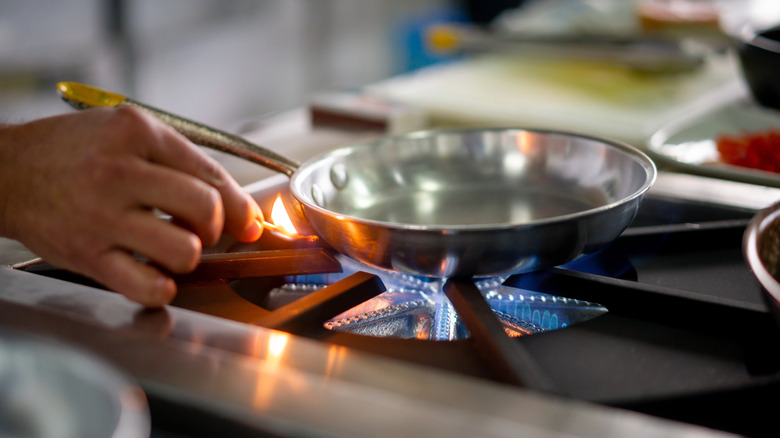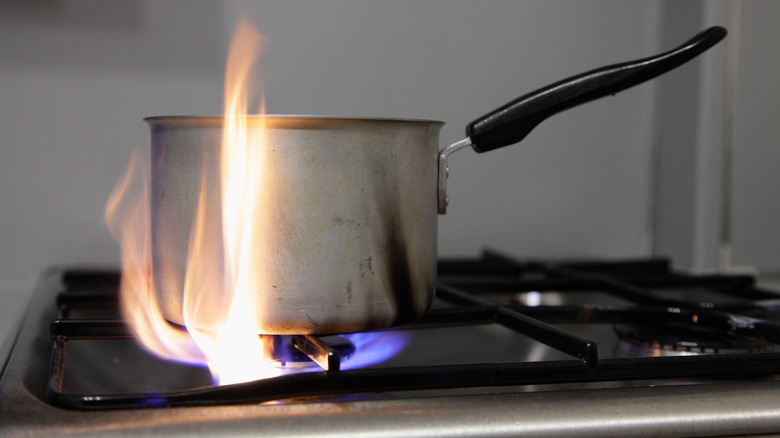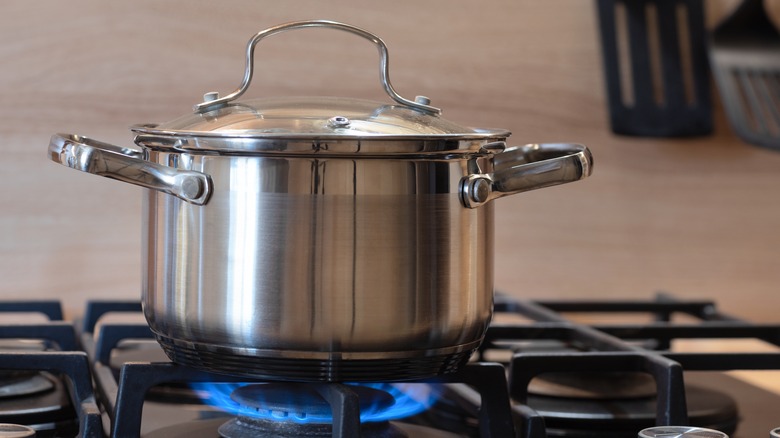The Gas Stove Burner Mistake You Need To Stop Making
Gas stoves offer a fast-responding cooking method for everything from boiling water to heating a wok or cooking steaks on an indoor grill pan. While some chefs swear by the redeeming qualities of gas ranges, there are many ways the average cook might create wasteful or even harmful situations when using them. One of at least eight mistakes everyone makes when cooking on a gas stove top is using a small pan on a large burner. Not only is this inefficient, but this mismatch can damage cookware and cause burns.
Grabbing that small sauté pan or sauce pot might be convenient for a single fried egg or a small amount of beef au jus. However, deciding on the right size pan for the food you are making is only part of the equation. The next step is matching the pan to the burner. Instead of simply turning on your most-used burner (we know you have one), pair the pan size to the burner size on your gas range and consider the function of the burner you choose.
Inefficiencies and damage
If you place a pot on a burner with a gas ring that is larger than the pot, you're asking for trouble. There are several reasons this is a bad idea. The first is that it's wasteful. If the flames are not coming into contact with the bottom of the pan, that means heat is escaping out into the room. Although not a huge dollar sum, the wasteful practice of using a small pan on a large burner will cost you in the long run. It's also sending gasses into the room, contaminating the air. Plus, the burner won't be as efficient in warming the pan, so it will take longer for your cookware to get hot.
Perhaps even more concerning is the damage those flames can do to your pans. Just like any other type of open flame, a gas stove can and will blacken the bottom of your pots. If your pan is smaller than your burner, those same flames will also blacken the sides of your pot as they climb up the sides. This is especially true for hotter settings that cause the flames to climb higher.
Safety and cooking consistency
Those flames licking up the sides are not only inefficient and damaging to the sides of the pan, but they are also a safety hazard. Placing a small pot on a large burner means heat can lick up the sides, heating the handles and scorching or melting them. This increases the chances of burns, even with heat-resistant handles. The open flames also increase fire risk if they come into contact with sleeves, hot pads, kitchen towels, or grease.
Although safety and efficiency are crucial, matching pot size to burner size on a gas range is also important for cooking consistency. Since the flames of large burners are angled to heat across large pans, a small pan will heat from the outside and stay cooler in the center. Conversely, putting a large pot on a small burner will concentrate the heat in the center of the pot rather than dispersing it. Both lead to longer cooking times.
Matching your pot size to your burner is an important factor for optimal cooking conditions. However, you should understand the intended function of each of your gas stove burners, too. Some are intended to be high output for quick, hot cooking, while others have a lower output and are perfect for long simmers. So, while your favorite burner earned its place for a reason, efficient cooking, safety, and avoiding damage to your pans are all good reasons to start matching your pot to your burner size.


